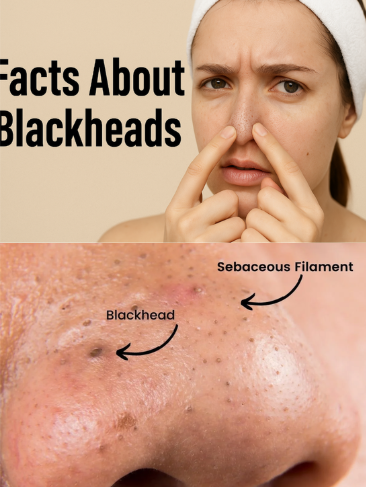
Blackheads are among the most stubborn and frustrating skin concerns. Those tiny dark spots on your face can feel impossible to remove, no matter how much you cleanse. While blackheads themselves are harmless, they can be a stepping stone to acne if you ignore them. Understanding what blackheads are, why they form, and how to prevent them is the smartest way to keep your skin clear and calm.
What Exactly Are Blackheads?
In dermatology, blackheads are called open comedones. They form when excess sebum (oil), dead skin cells, and debris collect inside a pore. Because the top of the pore stays open, that mixture is exposed to air and oxidizes—turning dark. That dark tip isn’t dirt; it’s oxidized oil and melanin. Whiteheads are the same plug but covered by a thin layer of skin, so they don’t oxidize.
Quick Facts You Should Know
- Blackheads can reappear every 20–40 days, which is why they seem relentless.
- They’re non-inflammatory (usually not red or painful) but can lead to pimples if bacteria join the party.
- They pop up where oil glands are active: nose, chin, cheeks, forehead, ears, neck, chest, shoulders, back, and arms.
- Over-scrubbing and squeezing often make things worse by irritating skin and enlarging pores’ appearance.
The Real Causes Behind Blackheads
- Overactive oil glands: Genetics and skin type play a big role in how much sebum you produce.
- Hormonal shifts: Puberty, menstrual cycles, pregnancy, menopause, and certain medications (e.g., androgens, lithium) can ramp up oil.
- Dead skin build-up: When shedding slows, dead cells mix with oil and clog pores.
- Cutibacterium acnes (formerly P. acnes): Normal skin bacteria that can aggravate clogged pores.
- Lifestyle and environment: Humidity, pollution, heavy sweating, and pore-clogging cosmetics increase congestion.
- Mechanical triggers: Shaving, waxing, or tight helmets/hats may open follicles and trap debris.
Sebaceous Filaments vs. Blackheads (Know the Difference)
Not every tiny dot on your nose is a blackhead. Sebaceous filaments are natural, hair-like structures that help channel oil to the skin’s surface. They’re typically grayish or tan, appear in clusters, and are smaller than true blackheads. When excess oil oxidizes, filaments can look darker—often mistaken for blackheads. Your goal isn’t to “erase” filaments (they’re normal) but to keep oil balanced so they’re less visible.
Video : 8 Facts About Blackheads You Should Know
Myths That Keep Skin Stuck
- Blackheads are dirt. False. They’re oxidized oil and melanin, not grime.
- Only oily skin gets blackheads. Any skin type can develop them if pores clog.
- Scrubs fix blackheads. Over-exfoliation irritates skin, boosts oil production, and can worsen congestion.
- Diet doesn’t matter. While it’s individual, high-glycemic foods and some dairy may exacerbate oiliness and breakouts for certain people.
Prevention That Actually Works
- Cleanse gently, twice daily: Use a mild, sulfate-free cleanser to remove excess oil and pollutants without stripping.
- Use chemical exfoliants: Salicylic acid (BHA) dives into pores to dissolve oil plugs; glycolic or lactic acid (AHA) smooths the surface to prevent build-up. Rotate 2–4x per week based on tolerance.
- Moisturize wisely: Choose lightweight, non-comedogenic gels or lotions to keep the barrier balanced (dehydration can trigger more oil).
- Sun protect daily: Non-comedogenic SPF helps prevent post-blemish marks and supports barrier health.
- Choose smarter makeup: Oil-free, non-comedogenic formulas; remove thoroughly every night.
- Mind your lifestyle: Manage stress, change pillowcases regularly, clean phone screens, and avoid touching your face.
Targeted Treatments for Stubborn Blackheads
- Salicylic acid (0.5–2%): The gold standard for decongesting pores. Look for cleansers, toners, or leave-on serums.
- Retinoids (adapalene/retinol): Normalize cell turnover, reduce clogs, and refine texture. Start low and go slow to minimize irritation.
- Clay masks (kaolin/bentonite): 1–2x weekly to absorb excess oil and reduce shine.
- Niacinamide (2–5%): Helps regulate sebum, refine the look of pores, and calm redness.
- Professional options: Chemical peels, microdermabrasion, gentle extractions by an esthetician/derm, or laser therapies when needed.
- Manual removal: Only by a trained pro with sterile tools—DIY squeezing can cause scarring and broken capillaries.
A Simple, Week-Long Routine Reset
- Morning: Gentle cleanse → Niacinamide or BHA serum → Lightweight moisturizer → Non-comedogenic SPF 30–50.
- Evening: Gentle cleanse → BHA or retinoid (alternate nights at first) → Light moisturizer.
- 2x weekly: Clay mask on T-zone; AHA night for surface smoothing (skip retinoid those nights).
- Always: Patch-test new actives, introduce one product at a time, and give it 4–6 weeks.
When to See a Dermatologist
If blackheads persist despite a consistent routine, or you’re seeing frequent inflamed breakouts, consult a professional. Prescription retinoids, tailored peels, or in-office extractions can fast-track results safely.
Video : The Different Types of Acne and How to Treat Them
Bottom Line
Blackheads aren’t a cleanliness problem—they’re a balancing act. Treat them with smart chemistry (BHA, retinoids), gentle habits, and oil-aware skincare. Skip the harsh scrubs and squeezing; instead, build a calm, consistent routine. With patience and the right products, clearer, smoother skin is absolutely within reach.


